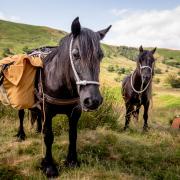A tree shipped from Lancashire to Gallipoli almost a century ago still flourishes in Turkish soil. Authors Martin Purdy and Ian Dawson report

In March 1922 a 58-year-old businessman called James Duckworth stepped from a cruise ship onto the shore of Gallipoli. He was accompanied by his wife and a host of other pilgrims equally desperate to visit this Mediterranean outpost. What made this man stand out was the fact that he did not land empty handed. He had a bucket containing the sapling of an English oak.
Duckworth, a Rochdale man who had inherited his family’s chain of greengrocery stores, had nursed the sapling for the duration of the 1,500 mile voyage. He and his wife planned to plant it by the spot where their eldest son, 19-year-old Second Lieutenant Eric Duckworth, had last been seen slumped among the barbed wire in front of a Turkish trench.
Soon after their son’s death they had used their influence to collect information about his final movements and they arrived at Gallipoli with letters and maps to aid them in their mission of commemoration.
Despite having little problem locating the area where Eric had fallen, the Duckworths concluded the tree would not survive in what was then an exposed, arid area where battlefield clearance work was still going on.
Instead, they decided to plant the tree in a nearby Imperial War Graves’ cemetery that contained the bodies of many of their boy’s comrades from the 1/6th Battalion Lancashire Fusiliers – a Territorial Army unit made up of men from the districts of Rochdale, Todmorden and Middleton.
Having paid the Turkish gardeners a considerable sum to water the tree, the couple headed for home. In the ensuing years their second son Geoffrey – and, in time, his offspring - would continue to visit the Dardanelles to ensure the tree was nurtured. Remarkably, it was, and more than nine decades later the lone Lancashire oak tree of Gallipoli provides a striking visual anomaly in what is now a Turkish national park.
However, what is perhaps even more surprising than this English tree’s survival is the fact that its existence, and the sacrifices of the Lancastrians that it commemorates, remains so little known. For these were soldiers of the 42nd East Lancashire Division; close to 20,000 men who had made history shortly after the outbreak of the First World War by becoming the first ever Territorials, to volunteer for overseas service.
We hope that our new book, The Gallipoli Oak, will go some small way to recording the sacrifices of these men and the story of the Duckworth family’s unique memorial – a memorial we first came across on a trip to Gallipoli in relation to our previous book, Doing Our Bit, which told the story of the First World War through the experiences of one small Lancashire town, Middleton in Rochdale.
The tree creates a striking impression: it is quite obviously alien to the other species that exist in what is, for much of the year, a rather dry, hostile and barren environment.
To local people like ourselves (we were both born in north Manchester) the poignancy of the tree’s existence is very much brought home by even a cursory tour of the graves that surround it; many of which belong to men from towns within the old East Lancashire boundary: Ashton, Oldham, Rochdale, Todmorden, Burnley to Blackburn and Wigan, Bury and Salford.
The reason for this mass gathering of Lancastrians is the fact that the Redoubt Commonwealth War Graves’ Cemetery is sited close to the scene of one of the most ferocious battles our local men fought in – the Battle of The Krithia Vineyard. The casualties suffered at this vineyard in August 1915 were among the highest endured by the East Lancashires, a claim to be made lightly. In the case of Eric Duckworth’s battalion, the 1/6th Fusiliers had left their training ground at Turton Bottoms, Bolton, 1,000 strong - and after just seven-months on Gallipoli more than a quarter were dead and as many as 800 wounded.
It was during the Battle of The Krithia Vineyard that young Duckworth was to fall. One of his men, a Private Heywood of Rochdale, said the teenager’s last words to his troops before leading them out into no-man’s land were: ‘Well lads, we are not going on a church parade today!’
Private Norman Howarth, another Rochdale resident, later wrote: ‘Lieut Duckworth led our platoon towards the vineyard. Many of the men were “green” reinforcements and halted at the first trench. About 20 led by Lieut Duckworth kept charging the second. Only three made it to the Turkish parapet - Private Porter, myself and Lieut Duckworth. Porter was about 10 yards to my left and we were busy shooting Turks. Porter crawled nearer to me and told me that LieutDuckworth had been shot.’
When the smoke lifted Howarth said that he could see Duckworth 30 or 40 yards to his left, ‘sat on the parapet [of the enemy trench] with his head on his chest.’
The Rev Fletcher, the battalion’s chaplain and former vicar of Rochdale, added: ‘Lieut Duckworth was right up against the Turkish trenches fighting bravely with his men when he was seen to fall, shot through the chest.’
As the fighting continued the bodies of many of the casualties were trapped beyond the reach of their comrades. Among them was Eric. His body was never to be recovered.
The Gallipoli Oak is available by sending your name and address, along with a cheque or postal order for £11.50 (inc p&p) made out to ‘Martin Purdy’, to Martin Purdy, Moonraker Publishing, 45 Eliza Street, Ramsbottom, BL0 0AT or you can purchase online via the website www.thegallipolioak.co.uk



























